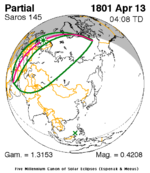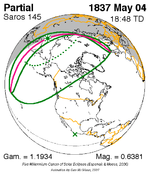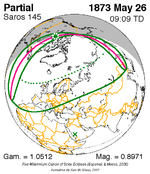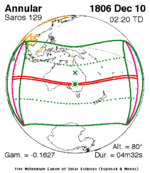Solar eclipse of June 30, 1992
| Solar eclipse of June 30, 1992 | |
|---|---|
| Type of eclipse | |
| Nature | Total |
| Gamma | −0.7512 |
| Magnitude | 1.0592 |
| Maximum eclipse | |
| Duration | 321 s (5 min 21 s) |
| Coordinates | 25°12′S 9°30′W / 25.2°S 9.5°W |
| Max. width of band | 294 km (183 mi) |
| Times (UTC) | |
| Greatest eclipse | 12:11:22 |
| References | |
| Saros | 146 (26 of 76) |
| Catalog # (SE5000) | 9491 |
A total solar eclipse occurred at the Moon's descending node of orbit on Tuesday, June 30, 1992,[1] with a magnitude of 1.0592. A solar eclipse occurs when the Moon passes between Earth and the Sun, thereby totally or partly obscuring the image of the Sun for a viewer on Earth. A total solar eclipse occurs when the Moon's apparent diameter is larger than the Sun's, blocking all direct sunlight, turning day into darkness. Totality occurs in a narrow path across Earth's surface, with the partial solar eclipse visible over a surrounding region thousands of kilometres wide. Occurring about 1.5 days before perigee (on July 2, 1992, at 1:30 UTC), the Moon's apparent diameter was larger.[2]
Totality was visible in southeastern Uruguay and southern tip of Rio Grande do Sul, Brazil. A partial eclipse was visible for parts of central South America, West Africa, Central Africa, and Southern Africa.
Observations
[edit]The path of totality was mostly on the sea and covered very little land. From the only land covered by it in southeasern Uruguay and southern tip of Brazil, totality occurred shortly after sunrise, with the solar zenith angle less than 3°. Observation from an airplane over the middle of South Atlantic Ocean, near the location of maximum eclipse, could offer a duration of totality of up to 10 minutes with the guarantee of clear weather. However, due to the limitations in the cruising capabilities and the economic cost, a feasible flight plan was to see 5 to 6 minutes of totality on the airplane. 48 people from the United States, Canada, Brazil, Germany, Japan and Great Britain boarded a VASP airline DC-10 plane, departing from Rio de Janeiro, Brazil, flying over the South Atlantic Ocean and returning to Rio de Janeiro. The passengers got off and the captain flew the airplane back to São Paulo. Although adjustment in the flying speed had to be made according to the take-off time and wind speed, the pilot flew the airplane into Moon's umbra within 1 second of the predicted time, and the passengers on board successfully saw the total eclipse. Accidentally, one of the ground support personnel did not exit the airplane before takeoff, and she also saw the eclipse. The pilots were also attracted by the eclipse, still watching the moon shadow moving into the distance and forgetting to fly the airplane back return even minutes after the third contact (the end of the total phase). The captain described this as the most unusual flight he ever commanded. VASP airline also provided a Boeing 737 plane to the Rio de Janeiro Planetarium. Planetarium staff, of their astronomy club, local dignitaries, politicians and celebrities were also invited.[3]
Images
[edit]Eclipse details
[edit]Shown below are two tables displaying details about this particular solar eclipse. The first table outlines times at which the moon's penumbra or umbra attains the specific parameter, and the second table describes various other parameters pertaining to this eclipse.[4]
| Event | Time (UTC) |
|---|---|
| First Penumbral External Contact | 1992 June 30 at 09:51:53.8 UTC |
| First Umbral External Contact | 1992 June 30 at 11:00:47.0 UTC |
| First Central Line | 1992 June 30 at 11:02:41.9 UTC |
| First Umbral Internal Contact | 1992 June 30 at 11:04:38.8 UTC |
| Greatest Duration | 1992 June 30 at 12:10:22.2 UTC |
| Greatest Eclipse | 1992 June 30 at 12:11:21.8 UTC |
| Ecliptic Conjunction | 1992 June 30 at 12:18:59.8 UTC |
| Equatorial Conjunction | 1992 June 30 at 12:24:21.9 UTC |
| Last Umbral Internal Contact | 1992 June 30 at 13:17:54.3 UTC |
| Last Central Line | 1992 June 30 at 13:19:52.9 UTC |
| Last Umbral External Contact | 1992 June 30 at 13:21:49.6 UTC |
| Last Penumbral External Contact | 1992 June 30 at 14:30:41.0 UTC |
| Parameter | Value |
|---|---|
| Eclipse Magnitude | 1.05916 |
| Eclipse Obscuration | 1.12183 |
| Gamma | −0.75120 |
| Sun Right Ascension | 06h38m55.2s |
| Sun Declination | +23°08'19.2" |
| Sun Semi-Diameter | 15'43.9" |
| Sun Equatorial Horizontal Parallax | 08.6" |
| Moon Right Ascension | 06h38m23.1s |
| Moon Declination | +22°23'36.1" |
| Moon Semi-Diameter | 16'28.8" |
| Moon Equatorial Horizontal Parallax | 1°00'29.0" |
| ΔT | 58.7 s |
Eclipse season
[edit]This eclipse is part of an eclipse season, a period, roughly every six months, when eclipses occur. Only two (or occasionally three) eclipse seasons occur each year, and each season lasts about 35 days and repeats just short of six months (173 days) later; thus two full eclipse seasons always occur each year. Either two or three eclipses happen each eclipse season. In the sequence below, each eclipse is separated by a fortnight.
| June 15 Ascending node (full moon) |
June 30 Descending node (new moon) |
|---|---|
 |

|
| Partial lunar eclipse Lunar Saros 120 |
Total solar eclipse Solar Saros 146 |
Related eclipses
[edit]Eclipses in 1992
[edit]- An annular solar eclipse on January 4.
- A partial lunar eclipse on June 15.
- A total solar eclipse on June 30.
- A total lunar eclipse on December 9.
- A partial solar eclipse on December 24.
Metonic
[edit]- Preceded by: Solar eclipse of September 11, 1988
- Followed by: Solar eclipse of April 17, 1996
Tzolkinex
[edit]- Preceded by: Solar eclipse of May 19, 1985
- Followed by: Solar eclipse of August 11, 1999
Half-Saros
[edit]- Preceded by: Lunar eclipse of June 25, 1983
- Followed by: Lunar eclipse of July 5, 2001
Tritos
[edit]- Preceded by: Solar eclipse of July 31, 1981
- Followed by: Solar eclipse of May 31, 2003
Solar Saros 146
[edit]- Preceded by: Solar eclipse of June 20, 1974
- Followed by: Solar eclipse of July 11, 2010
Inex
[edit]- Preceded by: Solar eclipse of July 20, 1963
- Followed by: Solar eclipse of June 10, 2021
Triad
[edit]- Preceded by: Solar eclipse of August 30, 1905
- Followed by: Solar eclipse of May 1, 2079
Solar eclipses of 1990–1992
[edit]This eclipse is a member of a semester series. An eclipse in a semester series of solar eclipses repeats approximately every 177 days and 4 hours (a semester) at alternating nodes of the Moon's orbit.[5]
| Solar eclipse series sets from 1990 to 1992 | ||||||
|---|---|---|---|---|---|---|
| Ascending node | Descending node | |||||
| Saros | Map | Gamma | Saros | Map | Gamma | |
| 121 | January 26, 1990 Annular |
−0.9457 | 126 Partial in Finland |
July 22, 1990 Total |
0.7597 | |
| 131 | January 15, 1991 Annular |
−0.2727 | 136 Totality in Playas del Coco, Costa Rica |
July 11, 1991 Total |
−0.0041 | |
| 141 | January 4, 1992 Annular |
0.4091 | 146 | June 30, 1992 Total |
−0.7512 | |
| 151 | December 24, 1992 Partial |
1.0711 | ||||
Saros 146
[edit]This eclipse is a part of Saros series 146, repeating every 18 years, 11 days, and containing 76 events. The series started with a partial solar eclipse on September 19, 1541. It contains total eclipses from May 29, 1938 through October 7, 2154; hybrid eclipses from October 17, 2172 through November 20, 2226; and annular eclipses from November 30, 2244 through August 10, 2659. The series ends at member 76 as a partial eclipse on December 29, 2893. Its eclipses are tabulated in three columns; every third eclipse in the same column is one exeligmos apart, so they all cast shadows over approximately the same parts of the Earth.
The longest duration of totality was produced by member 26 at 5 minutes, 21 seconds on June 30, 1992, and the longest duration of annularity will be produced by member 63 at 3 minutes, 30 seconds on August 10, 2659. All eclipses in this series occur at the Moon’s descending node of orbit.[6]
| Series members 16–37 occur between 1801 and 2200: | ||
|---|---|---|
| 16 | 17 | 18 |
 March 13, 1812 |
 March 24, 1830 |
 April 3, 1848 |
| 19 | 20 | 21 |
 April 15, 1866 |
 April 25, 1884 |
 May 7, 1902 |
| 22 | 23 | 24 |
 May 18, 1920 |
 May 29, 1938 |
 June 8, 1956 |
| 25 | 26 | 27 |
 June 20, 1974 |
 June 30, 1992 |
 July 11, 2010 |
| 28 | 29 | 30 |
 July 22, 2028 |
 August 2, 2046 |
 August 12, 2064 |
| 31 | 32 | 33 |
 August 24, 2082 |
 September 4, 2100 |
 September 15, 2118 |
| 34 | 35 | 36 |
 September 26, 2136 |
 October 7, 2154 |
 October 17, 2172 |
| 37 | ||
 October 29, 2190 | ||
Metonic series
[edit]The metonic series repeats eclipses every 19 years (6939.69 days), lasting about 5 cycles. Eclipses occur in nearly the same calendar date. In addition, the octon subseries repeats 1/5 of that or every 3.8 years (1387.94 days). All eclipses in this table occur at the Moon's descending node.
| 22 eclipse events between September 12, 1931 and July 1, 2011 | ||||
|---|---|---|---|---|
| September 11–12 | June 30–July 1 | April 17–19 | February 4–5 | November 22–23 |
| 114 | 116 | 118 | 120 | 122 |
 September 12, 1931 |
 June 30, 1935 |
 April 19, 1939 |
 February 4, 1943 |
 November 23, 1946 |
| 124 | 126 | 128 | 130 | 132 |
 September 12, 1950 |
 June 30, 1954 |
 April 19, 1958 |
 February 5, 1962 |
 November 23, 1965 |
| 134 | 136 | 138 | 140 | 142 |
 September 11, 1969 |
 June 30, 1973 |
 April 18, 1977 |
 February 4, 1981 |
 November 22, 1984 |
| 144 | 146 | 148 | 150 | 152 |
 September 11, 1988 |
 June 30, 1992 |
 April 17, 1996 |
 February 5, 2000 |
 November 23, 2003 |
| 154 | 156 | |||
 September 11, 2007 |
 July 1, 2011 | |||
Tritos series
[edit]This eclipse is a part of a tritos cycle, repeating at alternating nodes every 135 synodic months (≈ 3986.63 days, or 11 years minus 1 month). Their appearance and longitude are irregular due to a lack of synchronization with the anomalistic month (period of perigee), but groupings of 3 tritos cycles (≈ 33 years minus 3 months) come close (≈ 434.044 anomalistic months), so eclipses are similar in these groupings.
The partial solar eclipses on December 18, 2188 (part of Saros 164) and November 18, 2199 (part of Saros 165) are also a part of this series but are not included in the table below.
| Series members between 1801 and 2134 | ||||
|---|---|---|---|---|
 December 10, 1806 (Saros 129) |
 November 9, 1817 (Saros 130) |
 October 9, 1828 (Saros 131) |
 September 7, 1839 (Saros 132) |
 August 7, 1850 (Saros 133) |
 July 8, 1861 (Saros 134) |
 June 6, 1872 (Saros 135) |
 May 6, 1883 (Saros 136) |
 April 6, 1894 (Saros 137) |
 March 6, 1905 (Saros 138) |
 February 3, 1916 (Saros 139) |
 January 3, 1927 (Saros 140) |
 December 2, 1937 (Saros 141) |
 November 1, 1948 (Saros 142) |
 October 2, 1959 (Saros 143) |
 August 31, 1970 (Saros 144) |
 July 31, 1981 (Saros 145) |
 June 30, 1992 (Saros 146) |
 May 31, 2003 (Saros 147) |
 April 29, 2014 (Saros 148) |
 March 29, 2025 (Saros 149) |
 February 27, 2036 (Saros 150) |
 January 26, 2047 (Saros 151) |
 December 26, 2057 (Saros 152) |
 November 24, 2068 (Saros 153) |
 October 24, 2079 (Saros 154) |
 September 23, 2090 (Saros 155) |
 August 24, 2101 (Saros 156) |
 July 23, 2112 (Saros 157) |
 June 23, 2123 (Saros 158) |
 May 23, 2134 (Saros 159) | ||||
Inex series
[edit]This eclipse is a part of the long period inex cycle, repeating at alternating nodes, every 358 synodic months (≈ 10,571.95 days, or 29 years minus 20 days). Their appearance and longitude are irregular due to a lack of synchronization with the anomalistic month (period of perigee). However, groupings of 3 inex cycles (≈ 87 years minus 2 months) comes close (≈ 1,151.02 anomalistic months), so eclipses are similar in these groupings.
| Series members between 1801 and 2200 | ||
|---|---|---|
 October 29, 1818 (Saros 140) |
 October 9, 1847 (Saros 141) |
 September 17, 1876 (Saros 142) |
 August 30, 1905 (Saros 143) |
 August 10, 1934 (Saros 144) |
 July 20, 1963 (Saros 145) |
 June 30, 1992 (Saros 146) |
 June 10, 2021 (Saros 147) |
 May 20, 2050 (Saros 148) |
 May 1, 2079 (Saros 149) |
 April 11, 2108 (Saros 150) |
 March 21, 2137 (Saros 151) |
 March 2, 2166 (Saros 152) |
 February 10, 2195 (Saros 153) |
|
Notes
[edit]- ^ "June 30, 1992 Total Solar Eclipse". timeanddate. Retrieved August 10, 2024.
- ^ "Moon Distances for London, United Kingdom, England". timeanddate. Retrieved August 10, 2024.
- ^ Glenn Schneider, Craig Small, Joel Moskowitz (July 18, 1992). "The Great Airborne Eclipse Chase of 1992". Archived from the original on November 25, 2020.
{{cite web}}: CS1 maint: multiple names: authors list (link) - ^ "Total Solar Eclipse of 1992 Jun 30". EclipseWise.com. Retrieved August 10, 2024.
- ^ van Gent, R.H. "Solar- and Lunar-Eclipse Predictions from Antiquity to the Present". A Catalogue of Eclipse Cycles. Utrecht University. Retrieved October 6, 2018.
- ^ "NASA - Catalog of Solar Eclipses of Saros 146". eclipse.gsfc.nasa.gov.
References
[edit]- Earth visibility chart and eclipse statistics Eclipse Predictions by Fred Espenak, NASA/GSFC





